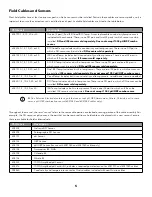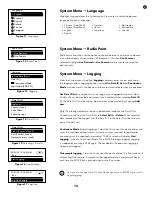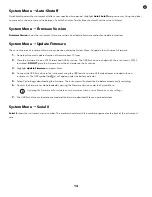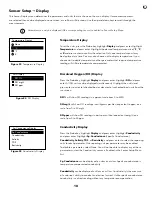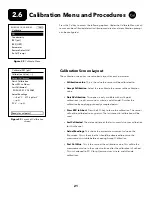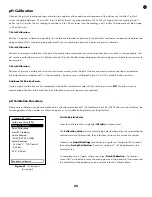
17
ISE Sensor Setup (pH, ORP, Ammonium, Nitrate, Chloride)
WARNING
: Ammonium, Nitrate, and Chloride sensors should only be used at DEPTHS OF LESS THAN 55 FEET (17
METERS). Use of the sensors at greater depths is likely to permanently damage the sensor membrane.
WARNING
: Ammonium, Nitrate, and Chloride sensors should only be used in FRESHWATER.
Under the Sensor Setup menu, highlight
ISE1
or
ISE2
and press Enter.
Enabled
allows you to enable or disable the ISE function and select which ISE
sensor is installed on the cable. Highlight Enabled and press Enter to activate
(checked box) or deactivate (unchecked box) the ISE channel. Disable the ISE
channel(s) if no ISE is installed.
If only using one ISE with the Quatro cable, it must be installed in port 1
(i.e. ISE1). If the Pro Series cable being used only has one port, only enable
ISE1.
If enabling pH, the instrument will ask for a buffer set to be identified. The selected option will be displayed in [brackets] next
to pH (see screenshot above).
USA
(4, 7, 10) and
NIST
(4.01, 6.86, 9.18) buffer sets are available options. Calibration values are
automatically compensated for temperature for USA and NIST buffer sets.
Off
should be selected if not using one of these buffer
sets or if you do not want calibration values to be automatically compensated for temperature.
Figure 22
Setup ISE1 or ISE2
03/03/20 10:34:42 AM
Setup ISE1
100%
Enabled
pH [USA]
ORP
Cl
NH4
NO3
Conductivity Sensor Setup
(continued)
IMPORTANT:
If the nature of the ionic species at the site changes between sampling studies, the TDS values will
be in error. TDS cannot be calculated accurately from specific conductance unless the make-up of the chemical
species in the water remains constant.
A
To change the multiplier, highlight TDS Constant and press enter. Use the numeric entry screen to enter a new value between 0 and
0.99. Highlight ENTER at the bottom of the screen and press Enter on the keypad to confirm.
%/°C
(Percent per Degree Celsius) is the temperature coefficient used to calculate temperature compensated Specific Conductance.
The default is 1.91% which is based on KCl standards. To change the temperature coefficient, highlight %/°C and press enter. Use
the numeric entry screen to enter a new value between 0 and 4%. Next, highlight ENTER at the bottom of the screen and press Enter
on the keypad to confirm.
TDS Constant
is a multiplier used to calculate an estimated TDS (Total Dissolved Solids) value from conductivity. The multiplier is
used to convert Specific Conductance in mS/cm to TDS in g/L. The default value is 0.65. This multiplier is highly dependent on the
nature of the ionic species present in the water sample. To be assured of moderate accuracy for the conversion, you must determine
a multiplier for the water at your sampling site. Use the following procedure to determine the multiplier for a specific sample:
1.
Determine the specific conductance of a water sample from the site.
2.
Filter a portion of water from the site.
3.
Completely evaporate the water from a carefully measured volume of the filtered sample to yield a dry solid.
4.
Accurately weigh the remaining solid.
5.
Divide the weight of the solid (in grams) by the volume of water used (in liters) to yield the TDS value in g/L for this site.
Divide the TDS value in g/L by the specific conductance of the water in mS/cm to yield the conversion multiplier. Be certain
to use correct units.



